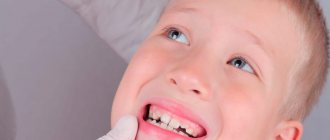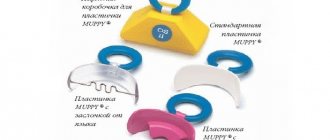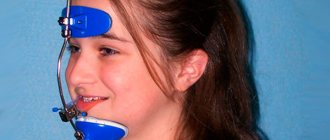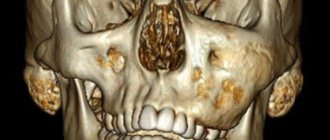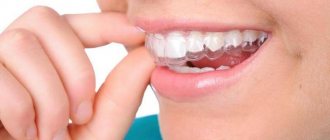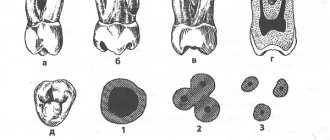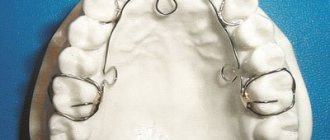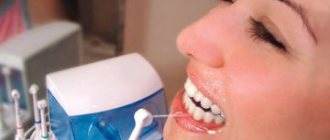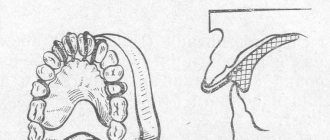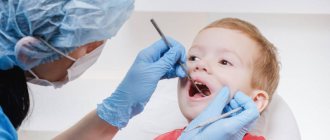- Pediatric orthodontics - correction of malocclusion in children
- Adult orthodontics - bite correction in adults
- Treatment with removable orthodontic appliances
- Correction of malocclusion without braces using mouthguards in adults.
- What orthodontic devices do our orthodontists use to correct the bite?
- How is braces treatment performed?
- What types of braces are there?
- How and why to choose an orthodontist?
- Reminder to the brace bearer
- What is orthognathy?
Do you know what awaits a patient who has braces installed? Let's find out!
When is orthodontic treatment with braces necessary?
A good reason to seek orthodontic treatment may be:
- Ugly smile, crooked teeth.
- Functional disorders of the dental system that worsen the patient’s quality of life: there is no ability to bite or chew well, teeth are destroyed and worn out.
- Problem with the jaw from overload of the temporomandibular joint (TMJ).
- Lack of space for prosthetics due to deformation of the dentition.
But it happens that the patient himself does not see the reasons for orthodontic treatment, and his dentist sends the patient to an orthodontist. Why?
Because his correct interdental contacts are impaired. The patient may not be aware of this; he is satisfied with the smile and is not bothered by anything. But the dentist sees the issue at the level of functioning of the dental system. If the teeth do not close properly, this means that the chewing load on the teeth is distributed unevenly. Sooner or later this will lead to illness. Timely orthodontic treatment is the only way to maintain healthy teeth for the rest of your life.
Diagnostic measures
The examination of patients in need of orthodontic treatment is carried out according to a standard procedure and begins with a survey, assessment of the facial profile and examination of the oral cavity.
From a survey of parents (if the patient is a child), the course of pregnancy and childbirth, details of feeding, the time of eruption of the “milk jugs”, and the beginning of their replacement with permanent elements are clarified.
During diagnosis, not only the condition of the dentofacial apparatus, but also the condition of the organism as a whole should be taken into account.
The following parameters are assessed:
- Functionality of the jaw system (tonus of masticatory muscles, condition of the TMJ).
- Type of facial profile and its features (symmetry, severity of the nasolabial and chin folds, height of the thirds of the face).
- Position of teeth and their condition (presence of caries, pulpitis, periodontitis, etc.).
- Type of bite (jaw relationship). Allows you to determine what type of therapy will be used - devices, growth modification, or a combination of surgery with the installation of corrective devices.
- Condition of the oral mucosa (presence of inflammatory processes, periodontitis, periodontal disease, gingivitis, etc.)
- Violation of facial aesthetics (asymmetry, smile outlines, etc.)
- Type of patient's body (formed or growing).
The presence of systemic or local pathologies is also required to be determined.
Making plaster models
A diagnostic plaster model of the jaws is necessary for the orthodontist to determine all the nuances of occlusion, select an orthodontic device and develop the necessary tactics.
Their production involves taking alginate or silicone impressions from the jaw rows and molding exact plaster copies.
In most cases, models of both jaws are made. They are installed in an articulator - a device with which you can simulate any movement of the jaws.
An alternative to a plaster model is a 3D VTO (three-dimensional visual treatment target), a virtual model created on a computer.
OPTG (Orthopantomogram)
Orthopantomography (OPTG) or panoramic radiography - obtaining a detailed X-ray image of all teeth along with the jaws and adjacent areas of the facial skeleton.
In orthopantomography, the X-ray emitter and receiver move synchronously around the patient's head, forming a flat image of the skull and jaw.
OPTG refers to primary x-ray dental examinations, which allow one to obtain a general idea of the condition of the jaw apparatus. There are 2 types of OPTG - film and digital. Currently, the digital version is mainly used.
OPTG is one of the basic diagnostic measures, without which it is impossible to draw up an adequate treatment plan. The study allows us to establish:
- Presence, type and degree of dental damage - trauma, damage to integrity (caries, chips, fractures), condition of canals and wisdom teeth, status of dentures and implants, periapical changes, etc.
- Condition of the jaws and facial skeleton. The relative position of the HF and LF (bite), fractures, inflammation of bone tissue and periosteum (osteomyelitis, periostitis), condition of the paranasal sinuses, bone septa of the maxillary and paranasal sinuses.
- Periodontal damage and the general condition of the soft tissues of the jaws - inflammation, neoplasms, trauma.
OPTG is not only the most important component of diagnosis, but also a document that has legal force.
Using the Kois deprogrammer for diagnostic purposes.
Come here if you are interested in the essence of using separation rings in orthodontics.
At this address https://orto-info.ru/ortodonticheskoe-lechenie/podgotovitelnyiy-period/analizatora-hip-ploskosti.html we will talk about the purpose of the Hip plane analyzer.
TRG (teleradiogram)
Teleradiography or cephalometric analysis (cephalo-Greek Kephalē – head) is carried out to obtain an image of the skull and jaw apparatus in a lateral projection.
This perspective allows you to determine:
- growth vector of the maxillofacial bones (very important when treating children);
- position of the TMJ heads;
- angles of inclination of the frontal units.
Using a teleradiogram, the orthodontist evaluates:
- general structure of the facial region of the skull;
- relationship of the jaws with other elements of the face;
- position of teeth and condition of soft tissues;
- jaw growth (in children);
- jaw anomalies.
The information provided by the TRG (presence of micro- and macrognathia, incisor inclination angles, relative position of the jaws) cannot be obtained through clinical examination and analysis of plaster models.
After receiving the results, the TRG is analyzed and calculated, i.e., the calculation of cephalometric parameters necessary for planning.
The dimensions and mutual position of the jaws, the nature of occlusion, the condition of the facial soft tissues, linear and angular parameters of the jaws and teeth are analyzed.
How much does orthodontic treatment with braces cost?
The main part of the cost of orthodontic treatment consists of the cost of the orthodontic apparatus on which the treatment is performed and the cost of the orthodontist’s work.
You also need to include indirect costs here:
- Cost of initial orthodontic consultation.
- Cost of diagnostics.
- The cost of preparation for orthodontic treatment (sanitation of the oral cavity, professional hygiene, tooth extraction, if your treatment plan includes it.
- The cost of the necessary additional orthodontic equipment (springs, miniscrews, orthodontic rods - elastics, etc.)
- The cost of regular professional hygiene, which you will have to undergo every 4-6 months throughout the entire orthodontic treatment.
- Cost of special orthodontic daily hygiene products.
The cost of orthodontic treatment indicated on the website and in other public sources is always approximate, indicative for the patient. You can accurately calculate it specifically for your case after diagnosis and drawing up your treatment plan.
There are 2 main payment schemes for orthodontic treatment:
- Payment for each visit.
In this case, the patient pays for his orthodontic apparatus and for each separately provided service, according to the price list. - Payment in installments in equal payments.
With this payment scheme, after the treatment plan is approved, the patient makes an advance payment, which is usually equal to the cost of the orthodontic appliance with installation, and begins treatment.
The remaining amount is divided equally by the number of predicted months of treatment, and the patient pays a monthly payment. If the treatment is still ongoing, but its cost has already been paid, the patient continues treatment until the desired result is obtained without additional payments.
Patients of our clinic "GALA DENT" on Prosvet pay for orthodontic treatment according to the second payment scheme - equal monthly payments
, because we consider this form of payment more convenient and fair.
Read more about prices for dental services and payments in the section Payment system and prices.
How to choose braces?
When choosing orthodontic equipment with which the orthodontist will treat the patient, you need to take into account:
Types of orthodontic appliances we work with:
- Bracket systems (non-removable orthodontic devices).
- Classic metal self-ligating braces DamonQ
- Ceramic transparent braces Damon Clear / sapphire Inspire Ice
- Invisible lingual braces Incognito and WIN
- Individual bracket system Insignia
Why is it important to choose the right orthodontist?
Orthodontic treatment is long-term, it will last from a year or more, so the patient cannot immediately determine whether it is being treated well or not. If something in the treatment goes wrong due to the doctor’s fault, you will find out about it months, or maybe years, later. In order not to waste time, money, nerves and health, it is important to immediately choose a good orthodontist with whom you will also enjoy communicating for a long time. If you want to know our recommendations on how to do this so as not to regret it, read the article: “How and why to choose an orthodontist?”
Patient approval
When agreeing on a plan with the patient, informed consent must be obtained from him. This presupposes that the patient should be well informed about the dental anomaly he has, its causes and consequences, treatment methods (all possible options with a discussion of their advantages and disadvantages), his own obligations and upcoming financial expenses.
It is necessary that the patient understands orthodontic terminology. It is useful to give him similar examples of treatment with their results.
If necessary, if the patient disagrees with the chosen option, the plan must be adjusted. If there are no objections, the doctor receives written consent, one copy of which is given to the patient.
Teenagers over 16 years of age can make their own decisions. Parents usually decide for those under 16 years of age. However, children under 16 years of age can express their desire to undergo treatment, contrary to the opinion of their parents. In this case, the doctor is obliged to take into account the decision of the teenager (the “Jillick competence” law).
In the opposite situation, when the parents agree to treatment, but the teenager does not, the latter’s opinion takes precedence, and the operation should be postponed. The best option is when parents and children share the same view .
The patient's positive reaction to the doctor's actions and a trusting attitude towards him are necessary. If he doubts the need for treatment, it is better to postpone it.
It is advisable to indicate the treatment time in reserve. If the adjustment ends earlier, it will be a pleasant surprise for the patient. While the opposite situation (prolonged treatment compared to the plan) may violate the trusting relationship between him and the doctor.
Finally, the patient is given recommendations for caring for braces. They are simple, but mandatory:
- quality oral care. It is advisable to use all the means listed above;
- You need to brush your teeth after every meal. Do this carefully to avoid the bracket coming off, but for a longer period of time to remove food debris from each bracket;
- changing your diet is a mandatory requirement. Food should not be hard, too hot or cold.
Regular visits to the orthodontist are also necessary.
The video provides additional information on the topic of the article.
Goals and objectives of treatment
Ideally, the purpose of orthodontic treatment is to ensure optimal dental function , namely to create a functional bite. This popular word ( occlusion ) is key in orthodontics and apparently requires specific explanations.
Occlusion is the closure (in other words, occlusion) of the teeth. Tops with bottoms (or vice versa). Bite is contact. Tooth contact. Contact by definition. Nothing less. Moreover, not just any contact, but preferably dense and clearly projected. Those. Each tooth must intersect with strictly defined teeth of the opposite jaw (antagonist teeth). Read more about bite and occlusion here.
If there seems to be closure, but the teeth are in contact “with the wrong person,” this is already a problem. Deviation from the norm. Anomaly. And in the absence of contact (closing) of the upper and lower teeth, they don’t talk about bite at all. In this case, they only dream about bite. This situation is called disocclusion - lack of closure (occlusion), and therefore occlusion. Therefore, there is no such diagnosis as malocclusion . This is a very general definition. I have already said that the concept of “correct” immediately relaxes and “disarms”: if it is correct, then everything is in order. And the word “incorrect” immediately “strains.” On the other hand, it requires clarification (specifics): what, exactly, wrong ? “Irregularity” refers to the cause of bite problems. After all, you always need to clearly understand at what “level” the closure is broken. (See Levels of Bite Problems). So as not to confuse cause with effect . And most importantly with the secondary . After all, such “confusion” will certainly affect the result of treatment.
There are anomalies in which the teeth are almost perfectly straight. But there is no bite. This sometimes happens when it is not the teeth, but the jaws that are to blame for the malocclusion. And looking from the outside, other patients are perplexed: “Why are you going to the orthodontist..? Everything is “pretty” with you.” Only its owner can probably tell about the “charms” of such a problem, having felt it “from the inside.”
By the way, “crooked” teeth, by definition, cannot close correctly. It’s just that if this is the only reason, then it’s enough to put in order those “cubes” that will make up the bite. Namely, to ensure the correct shape of the dentition. In other words, fix your teeth. And if the reason is not in the teeth, or let’s say not only in them, then straightening the teeth is just the initial stage of treatment. “Slightly straightening” or “slightly straightening” teeth is not a problem at all, for example, with braces.
You can teach your neighbor, the plumber, Uncle Fedya, to “glue braces” in an hour, more or less correctly. And your teeth will be better tomorrow than yesterday. It’s just hard to call it treatment. And even more so, this is no skill. Is this the only thing they teach orthodontists? Agree, if it were so simple, then probably braces would be sold in a pharmacy. Came. I bought it with a prescription. And glued it at home. Beauty! What I mean is that the most popular question to an orthodontist is still “How much does it cost to get braces?”
There’s just one problem…”There are no purely dental problems in principle. And uneven teeth and an incorrect (abnormal) bite are always a consequence of problems at a deeper level. (See “Causes of malocclusion”, “Bite and posture” and “About the main thing”)
But despite this, a very popular question is:
“Is it possible to put braces only on the upper (or only on the lower) teeth?”
Or as an option: “Is it possible not to glue braces on the “sevens” (or “sixes”)?”
Of course it is possible. You can, in principle, put braces on two teeth. But what's the point? After all, even in the most simplified understanding of occlusion (I emphasize - in the most simplified), occlusion is the closure of the teeth. The top ones with the bottom ones. And how will we ensure this closure, how will we “pull” the upper teeth to the lower ones, how will we correct the bite if we limit ourselves in what we can do: put braces on one row of teeth or only on part of the teeth.
Do you remember what the coolest teeth straightening device is called? That's right: braces. System!!! But what kind of system is this when not all teeth have braces? This is not a system that works. And so... “a bunch of braces.” It is unclear why and why they were installed. I'm not saying that the arch will not be able to fully realize its potential when it is not installed on all teeth (braces).
And if you consider that the modern formulation of the concepts of occlusion and occlusion is not limited to describing only the closure of teeth, but considers everything much broader and deeper, then imagine the absurdity of such questions.
The first two echo another common question:
“How long does it take to heal?” (How long do you need to wear braces?)
The answer is simple: they must be worn “to the bitter end.” Those. until complete recovery, until the problem for which the treatment was started is solved. But to be honest, there to “wear” at all. They need to be treated , to solve specific problems.
By the way, not all bite problems can be solved with braces. After all, braces only solve the issue of “placement” of teeth on the jaw (“living space”). And there are no “purely dental” problems at all. “Crooked” teeth are always a consequence of disorders at deeper levels: maxillary, cranial, postural, visceral. And how to solve this with braces?
Therefore, the timing of treatment may vary greatly from patient to patient. The difference depends on the complexity of the anomaly, the level of the cause of “crooked teeth” and the volume of treatment procedures performed. In this regard, the relevance and importance of treatment planning becomes clear. And before that, accordingly, clarify the essence of the problem (anomaly) by carrying out diagnostic measures.
The fact that the treatment, let’s say, is not quick. It's true. But “that’s ce la vie.” And this point is discussed at the “start”. Everything is fair.
So decide in advance why you need straight teeth. If you just smile, i.e. in a decorative sense, this is the same level of treatment, the same terms, the same prices. Least expensive (remember the plumber neighbor described above). And if beauty and function are “in one bottle,” then this is a completely different amount of work, different goals and objectives. The work is different, the costs are different. But the “return”, that is, the results are also different. For the better.
CONCLUSION: There are teeth that are straight and without a good functional bite. But a correct bite can never happen without even, beautiful, and therefore healthy teeth. And healthy teeth are always a sign of overall health.
So what are we going to do, gentlemen? Make the right choice! And we will correctly define goals and clearly set tasks!
READ MORE: “About the main thing”, “Bite and posture”, “Correction and correction of bite”.
Make an appointment at the Filatov clinic
Social Like
Comments for the site
Cackl e
Stage 2 – installation of braces
You have thought and decided, in this case you inform your orthodontist about this and make an appointment.
At your appointment, everything will be explained to you in detail again, and you will be able to clarify any additional questions that may arise.
Next comes the actual installation of braces and the application of initial loads to them.
It is very good if, before treatment, you purchase special hygiene products for braces. The doctor always tells you exactly what you need to buy and how to use it.
We also recommend purchasing an irrigator in advance.
After installing braces, the longest stage begins – treatment.
Stage 3 – treatment with braces
Usually this stage lasts one and a half to two years. The patient comes to an appointment on average once a month, where the doctor performs certain manipulations with the orthodontic apparatus.
Braces can be vestibular or lingual; most modern braces are self-ligating.
The patient may also come because the braces have come off; this happens, for example, due to violation of the rules of oral hygiene or some kind of mechanical impact on the device.
Another reason for an unscheduled visit to the orthodontist is the installation of additional equipment or maintenance of braces, for example, the bite changes, and accordingly, archwires may need to be replaced.
Thus, the allotted time for treatment passes and you approach the 4th stage - removal of braces.
Stage 1 – consultation with an orthodontist
Although, strictly speaking, the first stage is an orthopantomogram. An orthomantomogram is a panoramic image of the entire jaw, allowing the doctor to assess the condition of the dentition, see problem teeth, places where there is not enough bone tissue. Understand whether preliminary sanitation, tooth extraction, etc. is necessary.
The validity period of an orthopantomogram is approximately six months. To avoid wasting time, do it right away.
You have come for a consultation, where the doctor, after an examination, will tell you about possible treatment options. He will estimate the cost of treatment, tell you about hygiene rules, etc. In general, you will receive all the information about the upcoming treatment.
As a rule, after a consultation, the patient thinks about what he heard and then makes a decision.
Procedure
Before starting treatment, mandatory preparation is required, which includes the following steps:
- visual examination of the oral cavity;
- Carrying out diagnostics, identifying contraindications, assessing pathology;
- analysis of information obtained as part of research;
- carrying out sanitation, treatment of diseases, including caries and inflammatory processes;
- office cleaning of hard and soft deposits of plaque.
Next, the bottom row is examined, selected as the basis. In most cases, it is not touched, but if the tilt is excessive forward or backward, the required corrective structure is selected and calculated. Then the upper dentition is assessed and the position of the individual elements is determined.
The next stages are:
- determining whether it is necessary to remove molars or whether it is possible to save all the teeth in the area;
- calculation of anchoring, protection factors against accidental movement of the device after installation;
- development of a treatment regimen, frequency of office visits to correct and monitor treatment, and timing of wearing the device;
- selection of a device for the retention period (mouth guards, lingual wire devices, retainers, crowns, activators and others are used).
